Tournament football always provides room for a team to cause shocks and go all the way due to the little number of games that are needed to be played.
The 2022 World Cup in Qatar has been a hotbed for upsets and surprising results. While African giants Morocco have dominated headlines, Croatia have also upset the apple cart once more.
In 2018, Zlatko Dalić’s side managed to reach the final of the competition in Russia. For this very reason, getting to the semi-finals this time around is seen as less of an impressive feat.
However, for a country with a population of under four million, labelling the achievement of consecutive semi-finals as incredible is an understatement.
Nonetheless, across the last two World Cups, Croatia failed to win a single knockout game in normal time.
In fact, in Qatar, Dalić’s men only mustered one victory in six matches and despite knocking out both Belgium and Brazil, many have claimed that Croatia were fortunate to get as far as they did.
In the semi-final against Argentina, this luck seemingly ran out as Lionel Messi and Julian Alvarez ran riot, making for a highly non-competitive final-four game.
But was it more than luck that aided Croatia in going so far in the tournament yet again? This tactical analysis, in the form of a team scout report, will look to provide readers with some answers.
This article will be an analysis of Croatia’s data as well as the tactics deployed by Dalić to see if the European minnows were in fact worthy of a spot in the penultimate knockout round of the World Cup.
Note: This piece was written prior to Saturday’s third-place playoff and so the data may be slightly outdated.
Goalscoring issues
When observing Croatia’s goalscoring statistics throughout the tournament, the reading isn’t woeful.
While scoring six goals in six matches isn’t wonderful, it does show an emphasis on having a solid defensive set-up instead which is vital in tournament football.
Morocco are a perfect example of this. Walid Regragui’s warriors scored merely five goals in the lead-up to the semi-finals but had conceded just once.
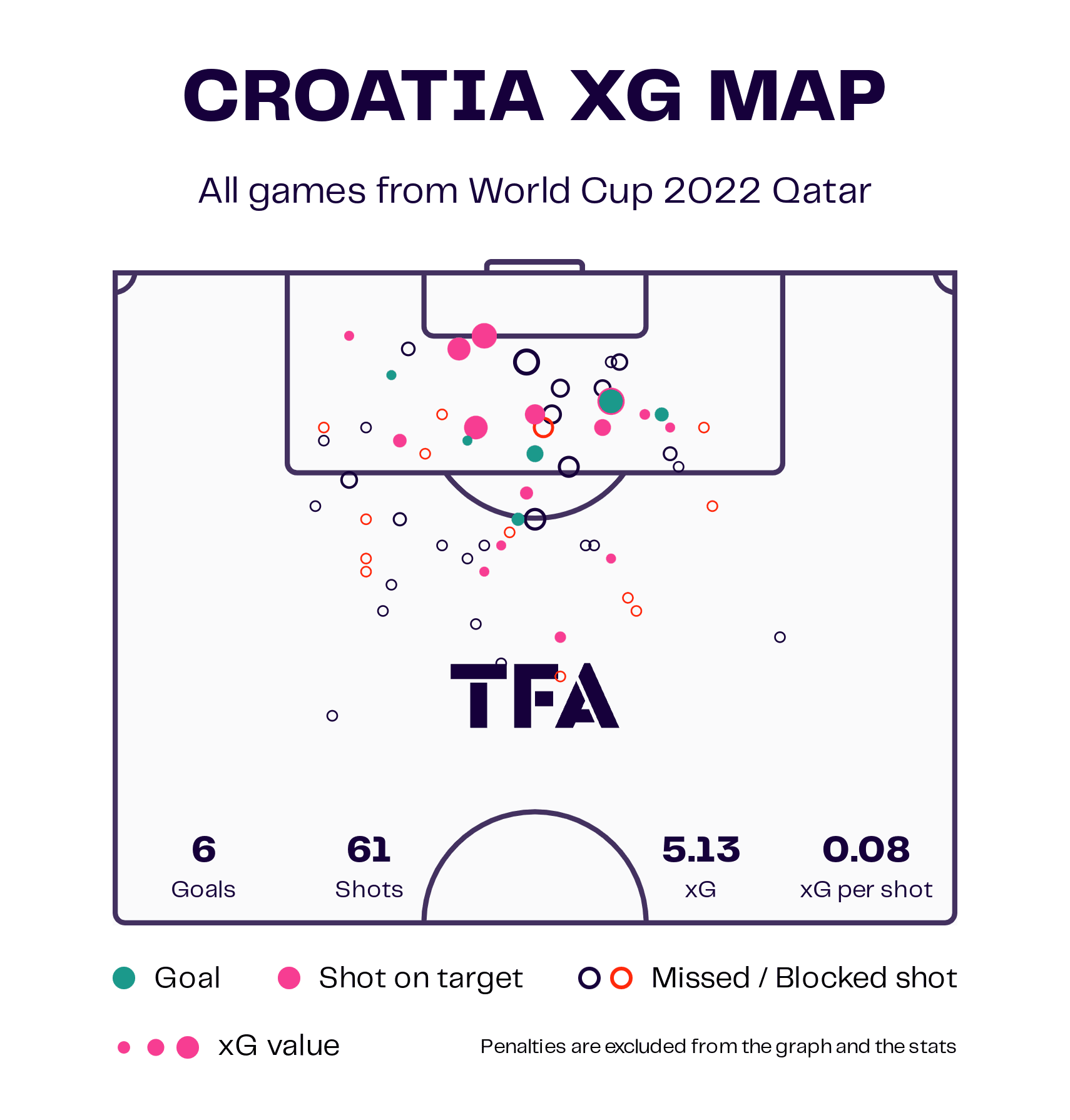
There are two worrying details about Croatia’s xG map that need to be considered. Firstly, each of the Vatreni’s shots had an extremely low xG on average, registering at around 0.08 xG per shot.
This certainly isn’t ideal over the course of 61 shots, as Croatia boasted from their first match against Morocco to their defeat to Argentina in the semis.
The low average xG of Croatia’s strikes played a massive helping hand in the side’s benign goalscoring numbers as most of the players’ shots had a very small chance of actually hitting the net.
The other worrying detail behind Croatia’s goalscoring stats is the context behind their numbers.
The 2018 finalists scored four of their six goals in one match, a 4-1 victory over Canada in the group phase. In terms of accumulated points, Canada were the joint-worst team in the contest, alongside Qatar, failing to pick up a single point.
When the match versus John Herdman’s North Americans is taken out of the equation, the data looks more grimacing regarding the remaining five results.
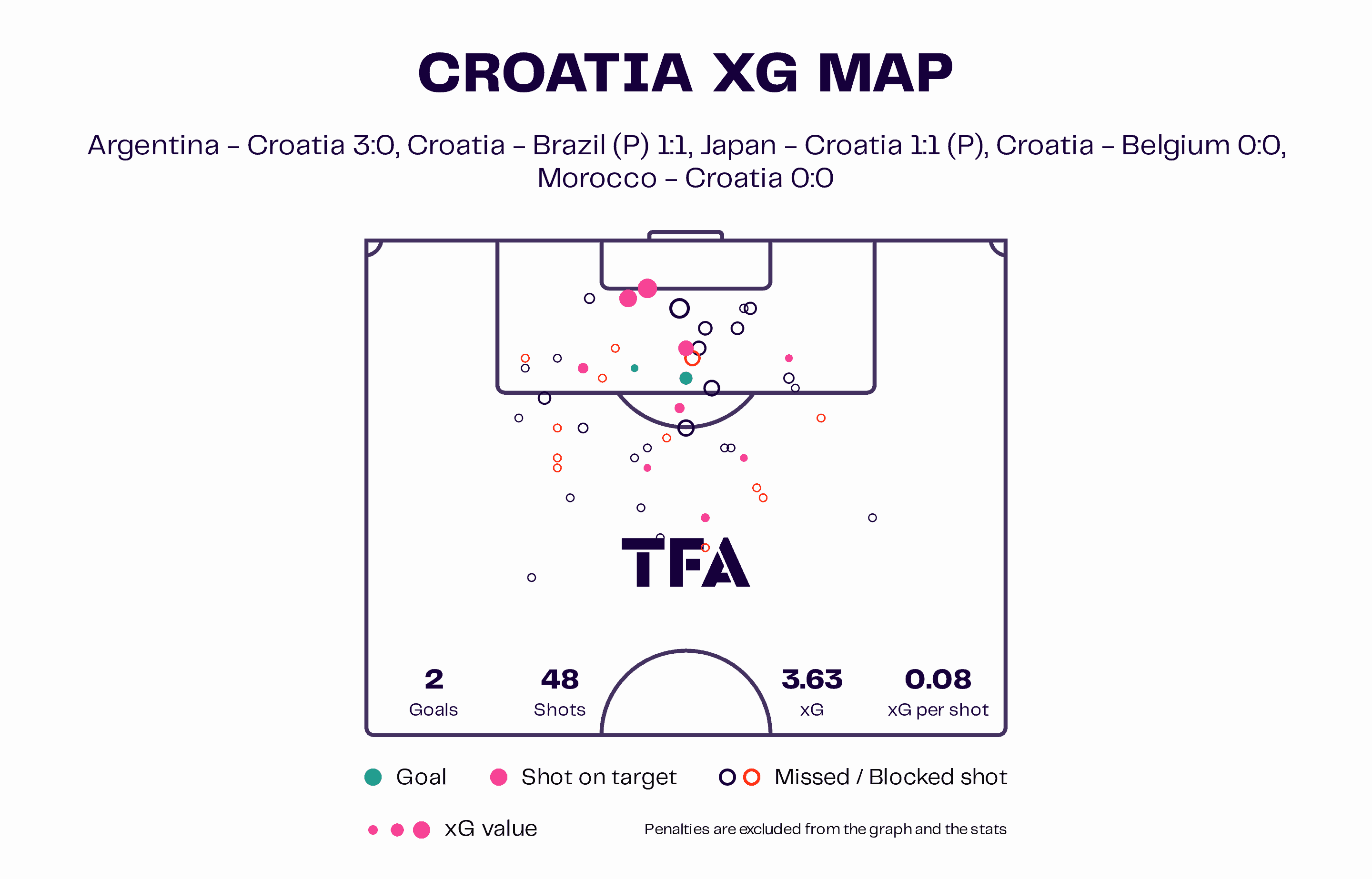
The xG flipped on its head. Including the Canada thrashing, Croatia were outperforming their xG slightly. Without taking this match into consideration, the European nation underperformed their xG of 3.63, scoring just twice.
What’s more striking is that the xG per shot average is even lower, teetering at 0.08 which explains the side’s poor conversion.
Croatia scored in normal time in just two matches – Canada and Japan in the Last-16. Dalić’s side went goalless in three of their World Cup games, and it took them until extra time to score versus Brazil to take the game to penalties.
Hence, the team’s lack of threat in front of goal in the semi-final against Argentina was certainly not a surprise.
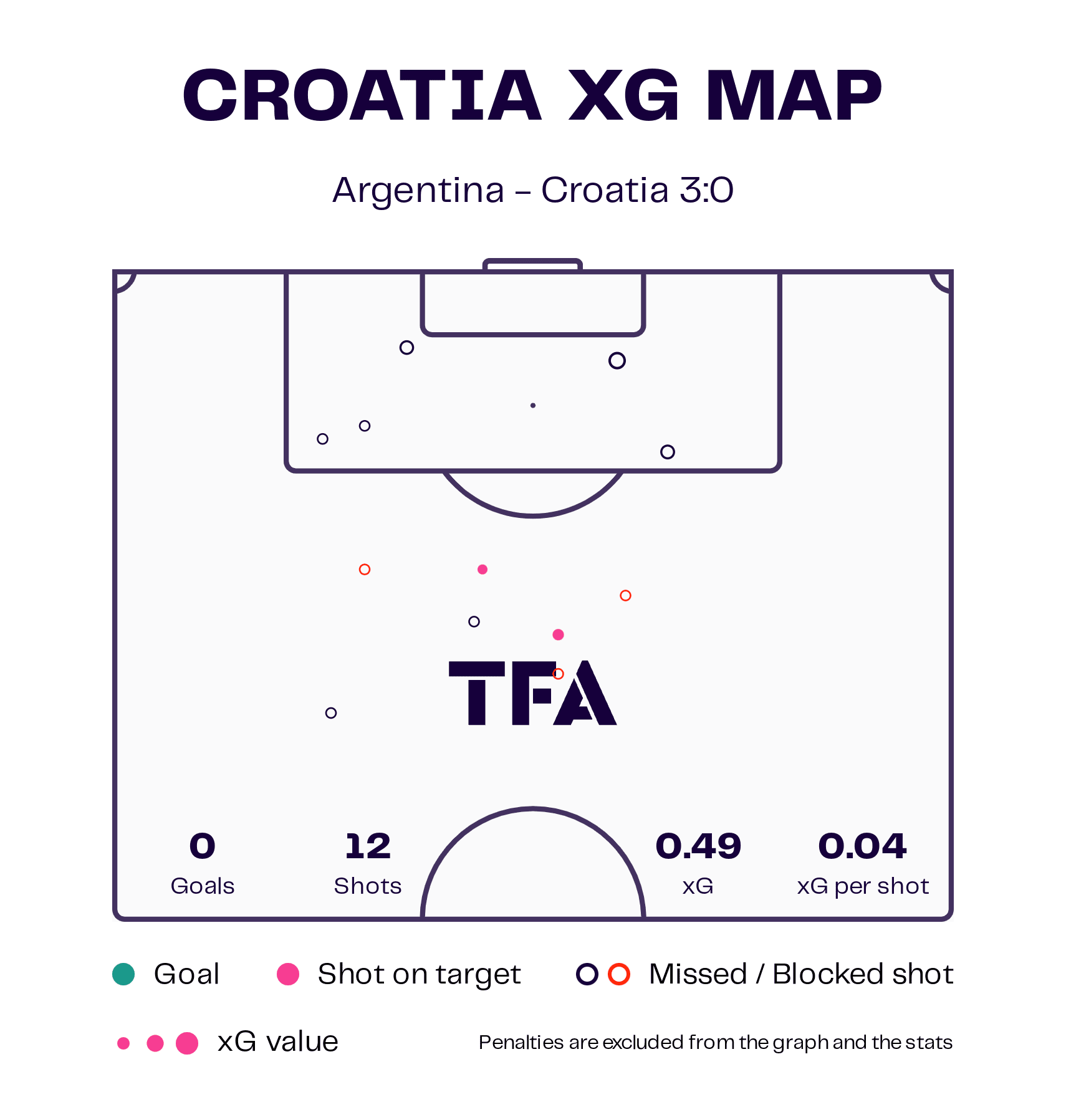
Despite having 12 shots against the South Americans, Croatia registered an xG of 0.49, with each shot averaging an xG of 0.04 which is ghastly for a semi-final of arguably the greatest competition in the sport.
Only two of these strikes were on target, but both were way outside the box and so had very little xG value.
In fact, Argentina registered a higher xG of 1.31 against Croatia in the semi-final than the European nation did in the quarters and the semis which spanned more than 200 minutes in total.
Tactical reasons
We’ve looked at the data behind Croatia’s underwhelming goalscoring record but now let’s take a look at the tactical reasons for this lack of potency.
Firstly, to provide context, take a look at the side’s overall xG map once more which is provided below to prevent you from having to scroll back up to the top. We know, we’re very good to you.

Another damning detail of this data viz is just how many shots Croatia were taking outside the penalty area. Long-range strikes are notoriously low percentage goalscoring opportunities. Croatia took roughly half of their 61 shots from outside the 18-yard box.
Particularly in the knockout phase, Dalić’s side struggled to create meaningful opportunities inside the area to give themselves the best chance to score.
Instead, a shoot-on-sight culture began to form at the World Cup, leading to individualistic attacks and selfishness in front of goal.
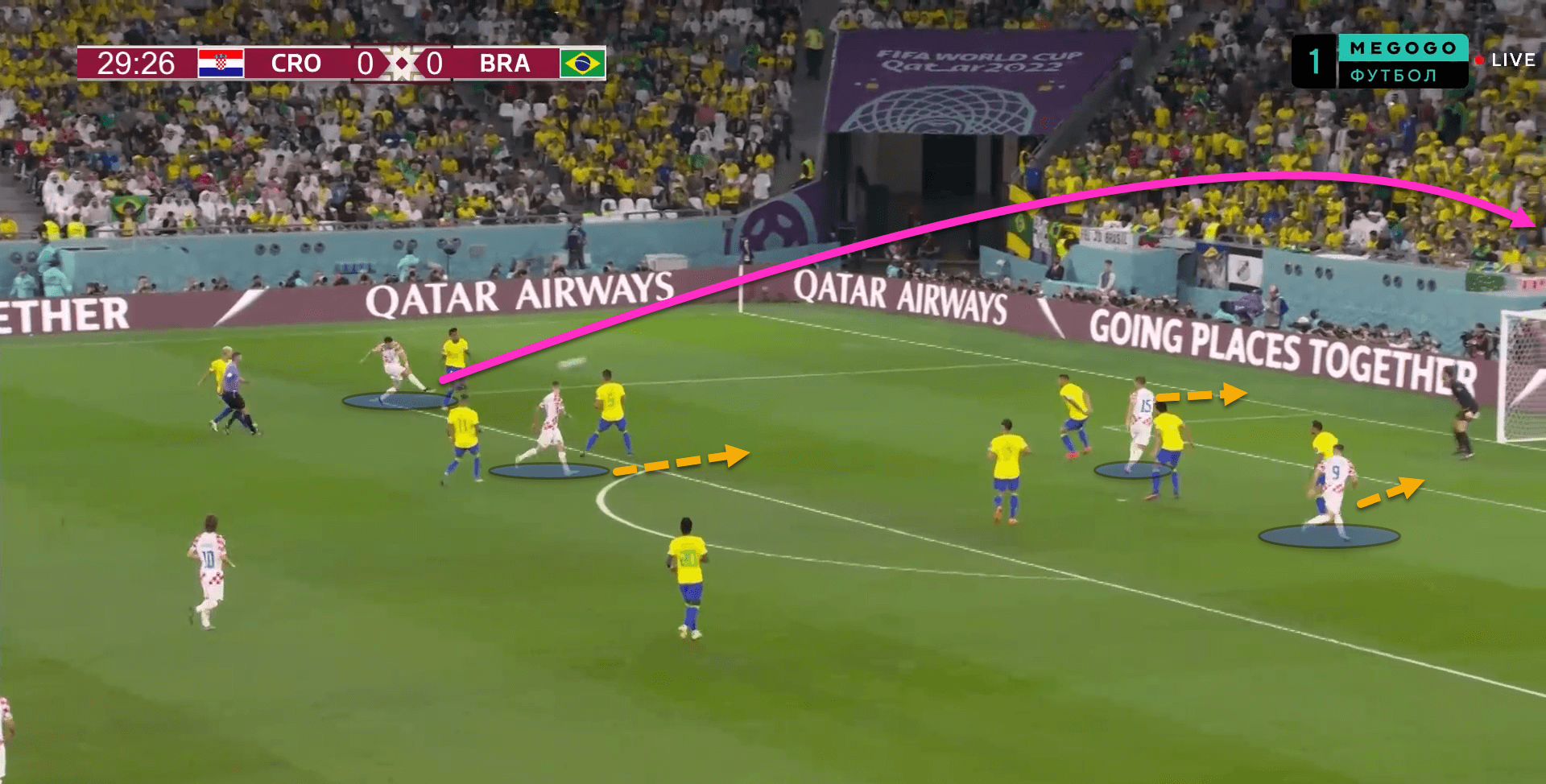
Here, Ivan Perisic on the left wing carried the ball forward on the flanks and cut inside on his favoured right foot.
Croatia had managed to get bodies forward in the Brazilian box and were expecting an inswinging cross to be whipped in by the Tottenham Hotspur forward, but they thought wrong.
The experienced attacker cut inside and smashed it over the bar, wasting a good opportunity for Croatia to score.
It’s not as if Brazil weren’t susceptible on the break either but players must make the correct decisions when counterattacking moments arise in order to be efficient.
In extra time, as Croatia faced an immediate exit from the tournament, the European side hit a perfect counterattack to equalise and send the game to penalties, which they subsequently won, progressing to the semis.
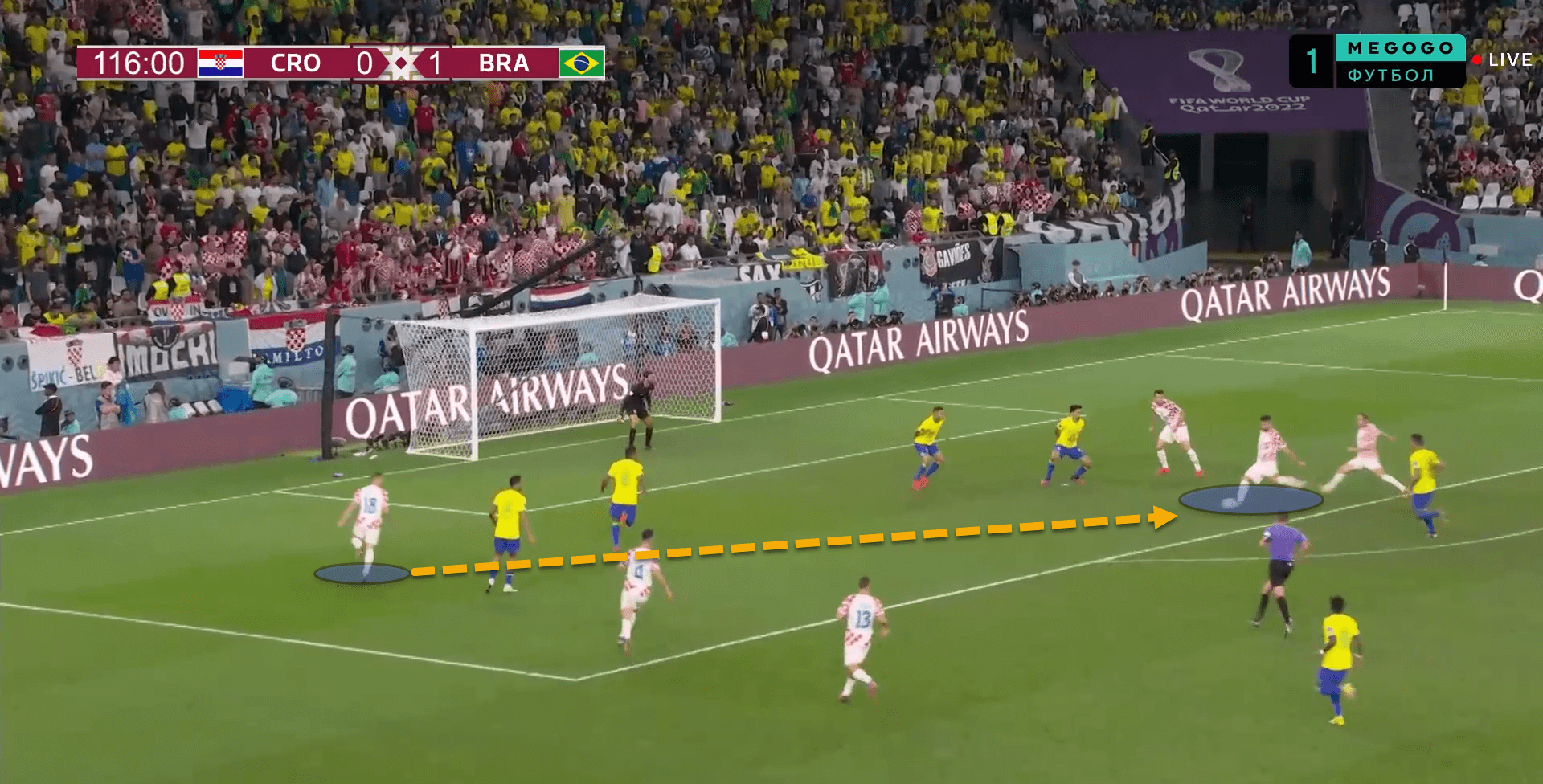
Mislav Oršić could have carried the ball to the byline or else cut inside and looked to have a go at goal himself. Nonetheless, the Dinamo Zagreb forward made the correct choice at the best moment, crossing it low onto the left foot of Bruno Petković who placed it past Alisson.
To Croatia’s credit, the team looked more dangerous on the break than during settled possession phases, although this was only really seen in the 4-1 thrashing of Canada and the equaliser against Brazil.
Regardless, the Canada victory showcased the team’s counterattacking prowess as they ripped John Herdman’s side to shreds.
When Croatia had established possession and were forced to work their way around their opponent’s defensive block, things became trickier because there was less space to run into.
Most of the time, Croatia’s attacking play came down to balls over the top of the backline to runners in behind, or else crosses into the box.
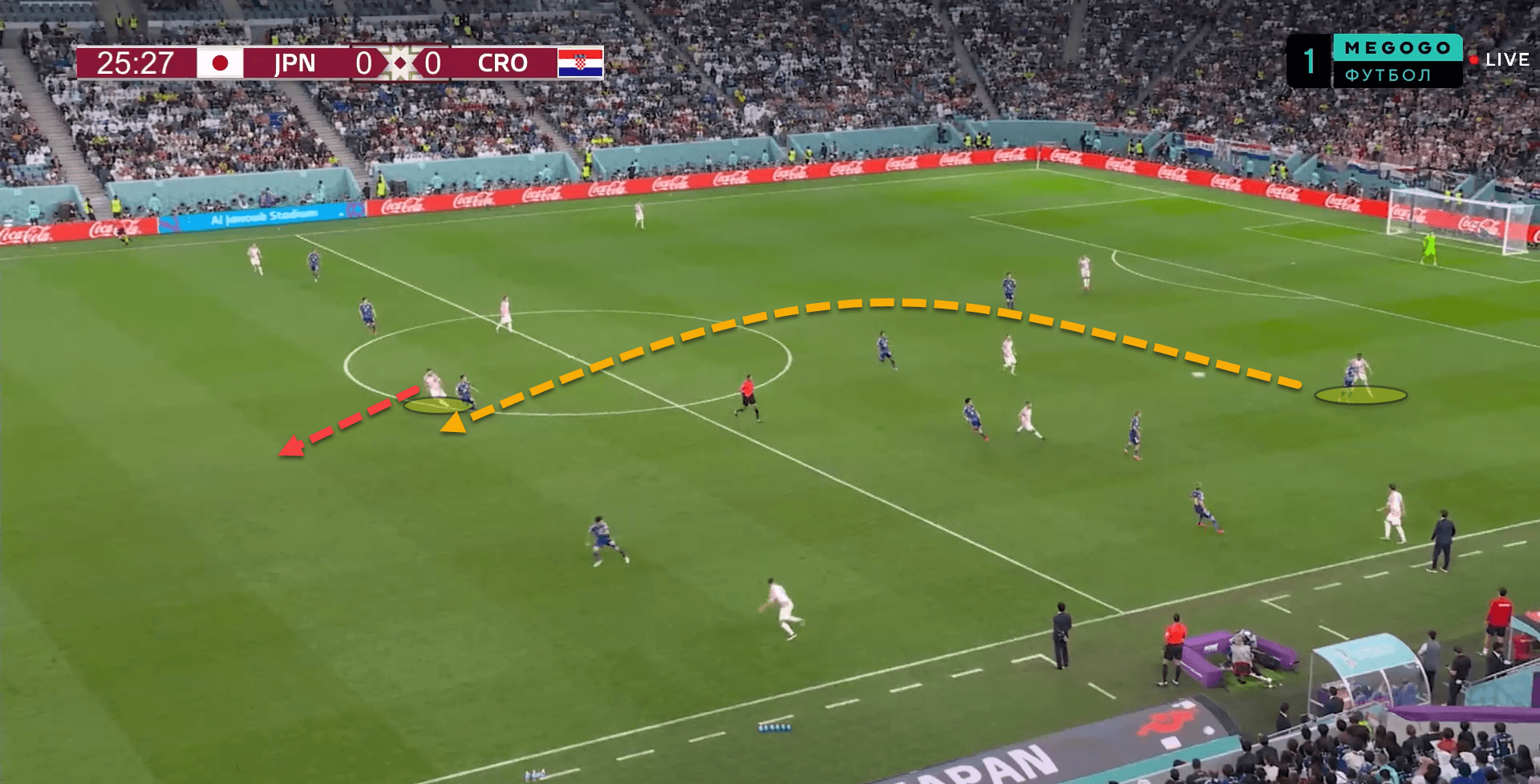
For example, Japan were defending in an extremely compact mid-block during the two sides’ Last-16 tie, cutting off space between the lines but leaving quite a lot of room between the centre-backs and the goalkeeper.
Croatia were unable to penetrate the Japanese block on the deck or through the flanks and so began going direct to attacking players running in behind.
This worked on a couple of occasions, but the nation still couldn’t create many clear-cut opportunities, registering an xG of just 0.96 over the course of 120 minutes of play.
When it comes to crossing, Croatia seemed to be geared towards having a proficient target man like Mario Mandzukic leading the line and bullying any centre-back that stands in his way.
However, since the former Juventus and Bayern Munich striker retired last year and is now working as the assistant manager of the national team, perhaps Dalić needs to reinvigorate the country’s attacking play which looked stale in Qatar.
Defensive resilience
While this piece has been highly critical of Croatia’s offensive displays at the World Cup, it may be fair to note that the team’s defensive resilience is potentially the main reason why they got so far this time around.
Croatia didn’t really press high up the pitch, particularly against opponents of higher quality such as Brazil and Argentina.
The Vatreni held a Passes allowed Per Defensive Action (PPDA) of 12 at the tournament, which is relatively high. Essentially, Croatia would allow their opponents to make 12 passes on average before stepping in and trying to win the ball back.
Usually, when the opposition are coming out from the back with the ball, Croatia drop off and look to form a compact mid-block in the middle of the pitch.
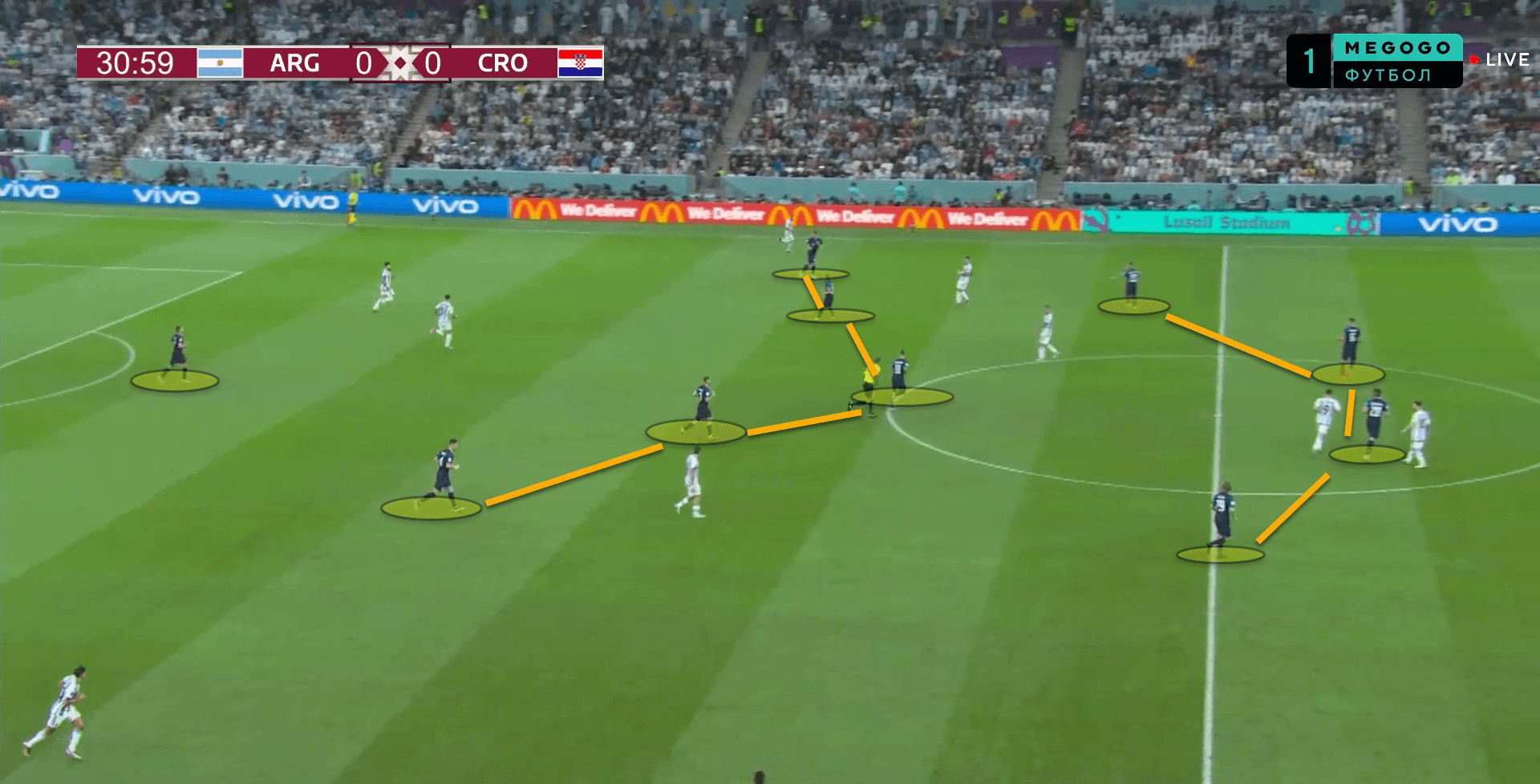
As the opposition progress further and further, Croatia drop lower and lower, although the block isn’t a passive one.
Dalić still wants his side to be pressing the ball-carrier, especially with his midfielders who work tirelessly off the ball to try and reclaim it by adopting a more man-for-man approach against their opposite numbers.
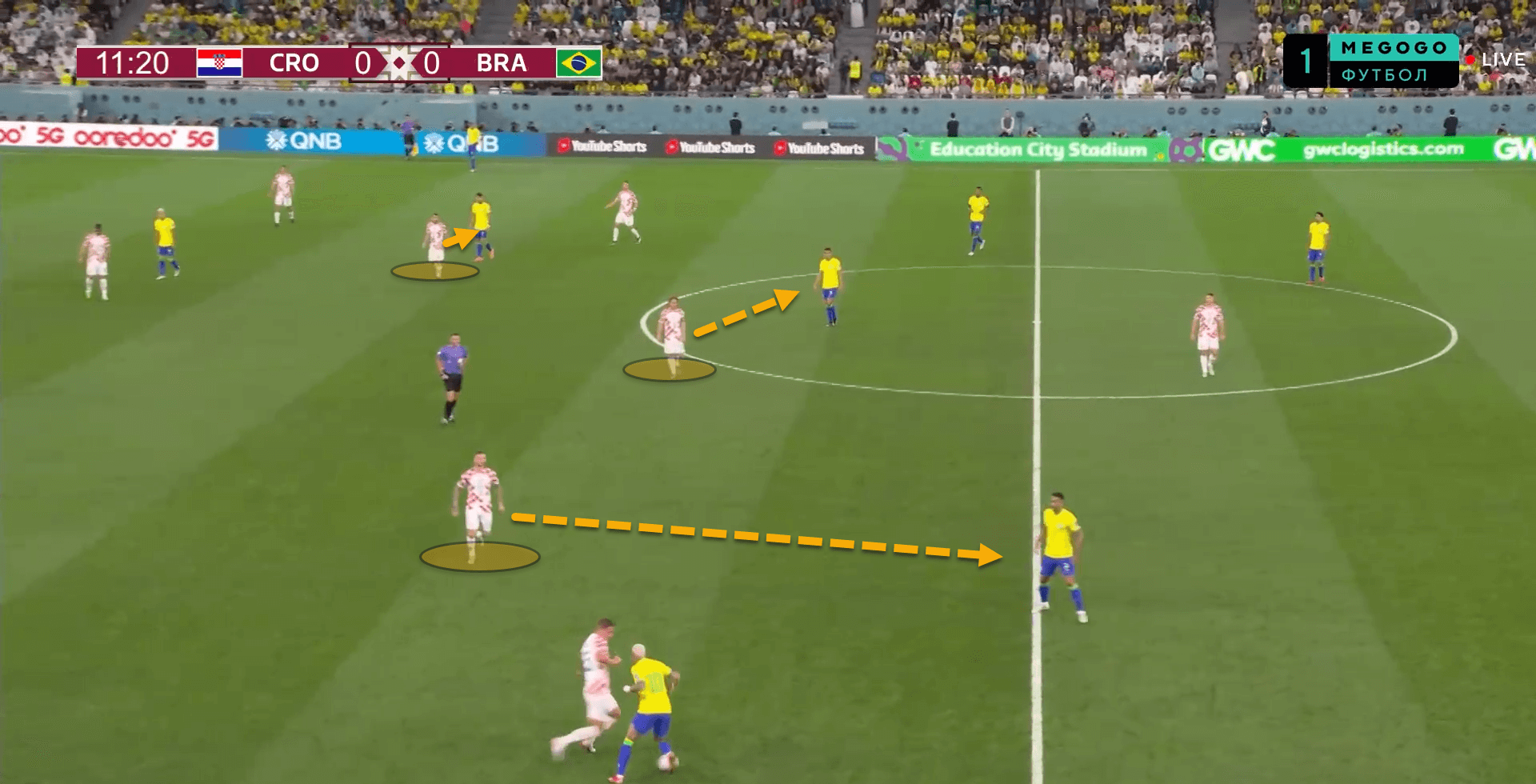
The man-marking is not strict from Croatia. Each of the three midfielders are simply tasked with picking up any player that moves into their zone which offers flexibility against teams that constantly rotate their midfield players.
This can be quite difficult to play against as it means that midfielders don’t have much time on the ball as they are being aggressively pressed by Croatia’s middlemen.
Nonetheless, Argentina spotted a weakness in Croatia’s backline during their semi-final clash between the two teams.
Croatia are quite slow to drop off in a deeper defensive block and the movement from the unit isn’t as coordinated as it should be.
Spotting this, La Albiceleste tried switching up their attacking play a little by hitting a ball directly over the top of the Croatian defence to Julian Alvarez who won a penalty after clashing with Dominik Livaković.
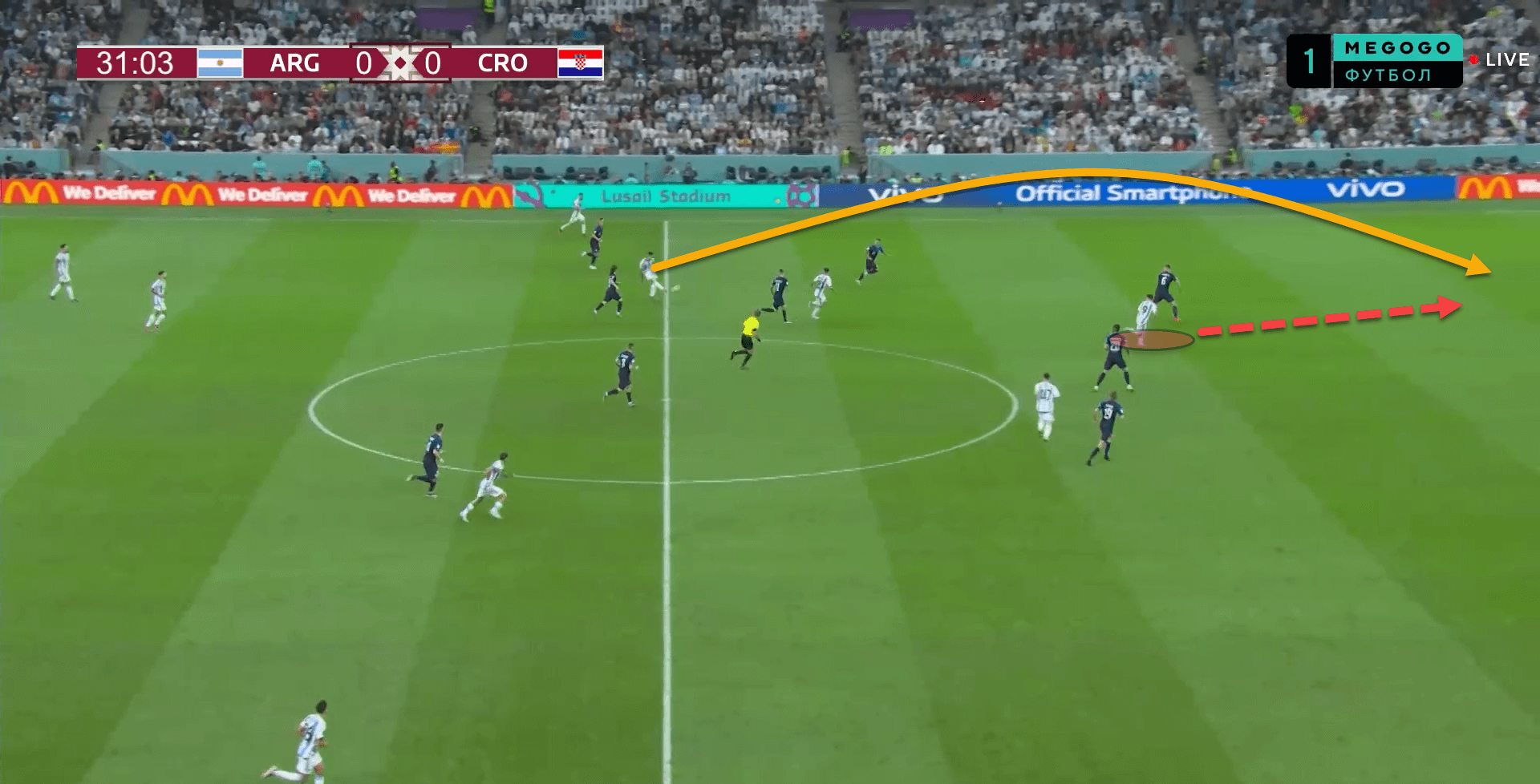
Unfortunately, this goal forced Croatia to take more risks in search of an equaliser and Argentina were able to pick them off by adding a second and third goal. Croatia’s poor performance in front of goal meant that getting back into the game was next to impossible, especially when Argentina scored to make it 2-0.
Nonetheless, over the course of their first six matches, Croatia conceded an xG of 7.44 but only allowed six goals to go past Livaković in goal, although half of these were in one match versus Argentina.
This a pretty decent showing considering the side played teams like Belgium, Morocco, Brazil and Argentina.
Conclusion
From analysing the data as well as the tactics of Croatia in Qatar, it’s fair to say that without a sturdy defensive performance throughout the tournament, Dalić and his players never would have gotten as far as they did.
Unfortunately, the team’s lacklustre attacking displays meant that even reaching the final four was a stretch and a dream of another final, and potentially winning the competition, was nothing more than a fantastical dream rather than a realistic possibility.






Comments